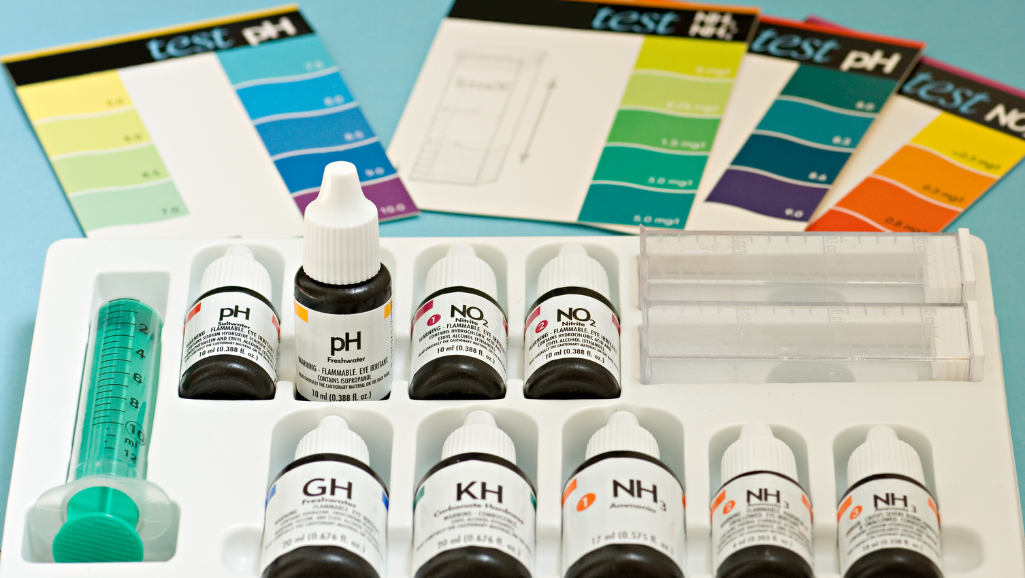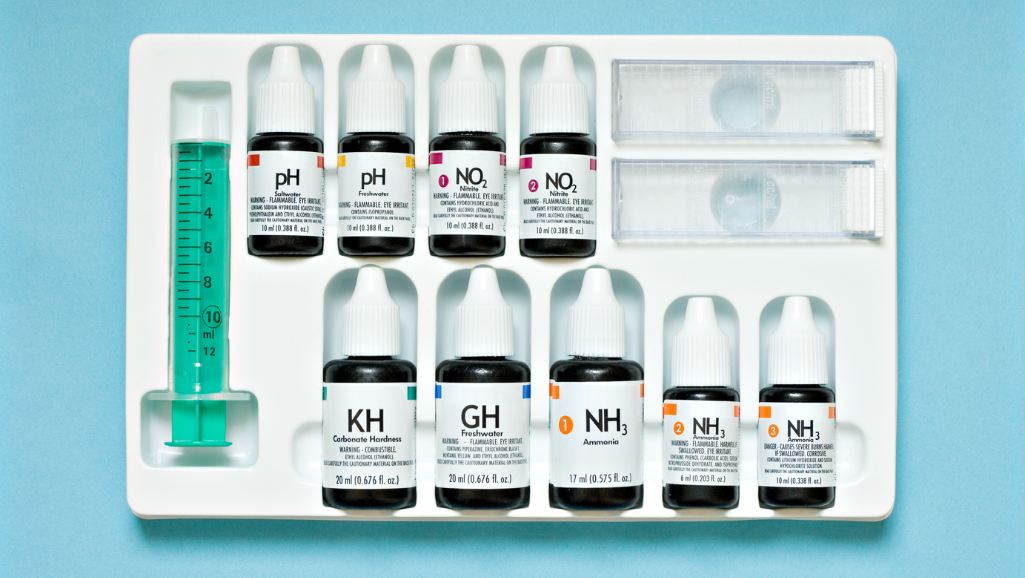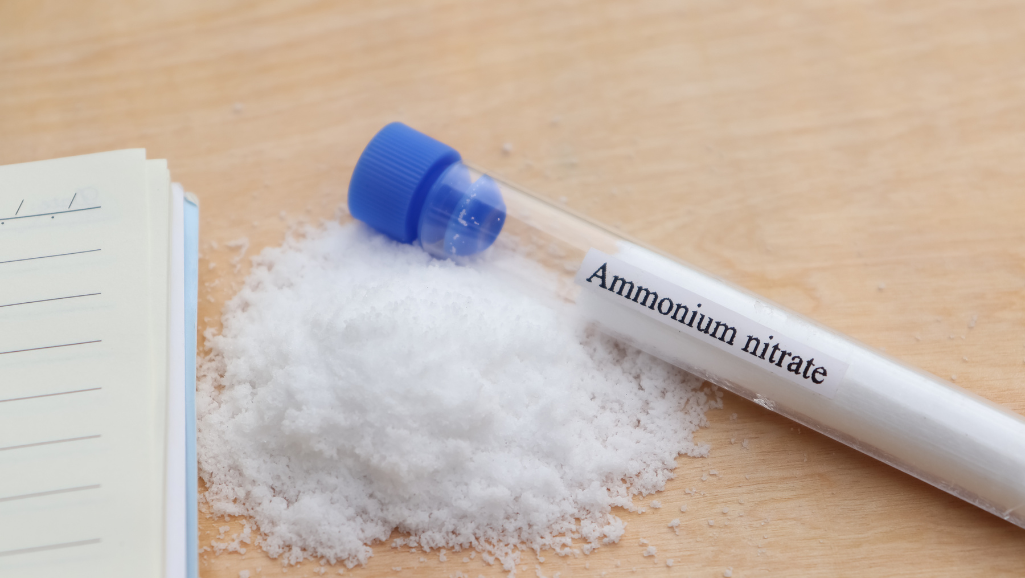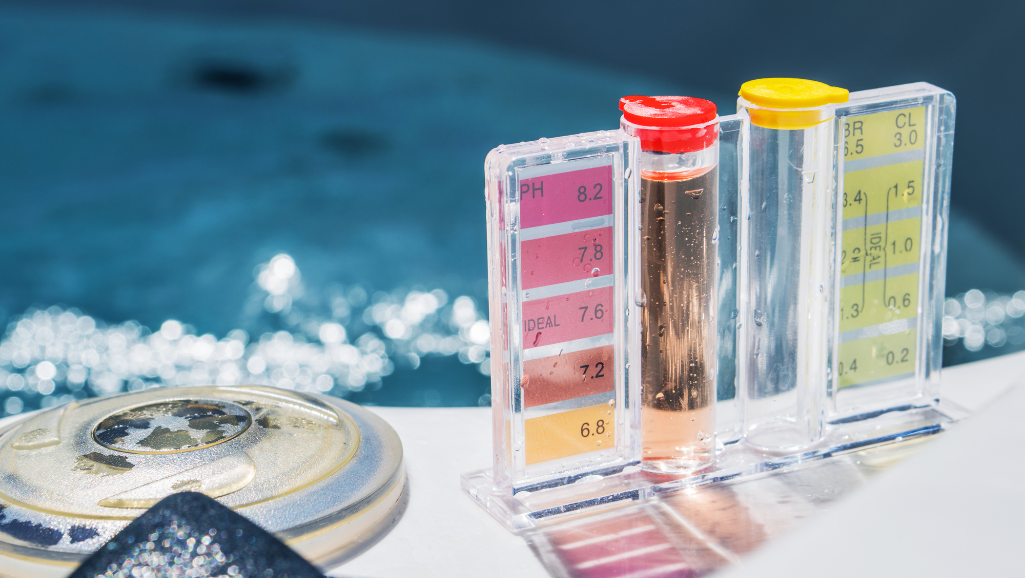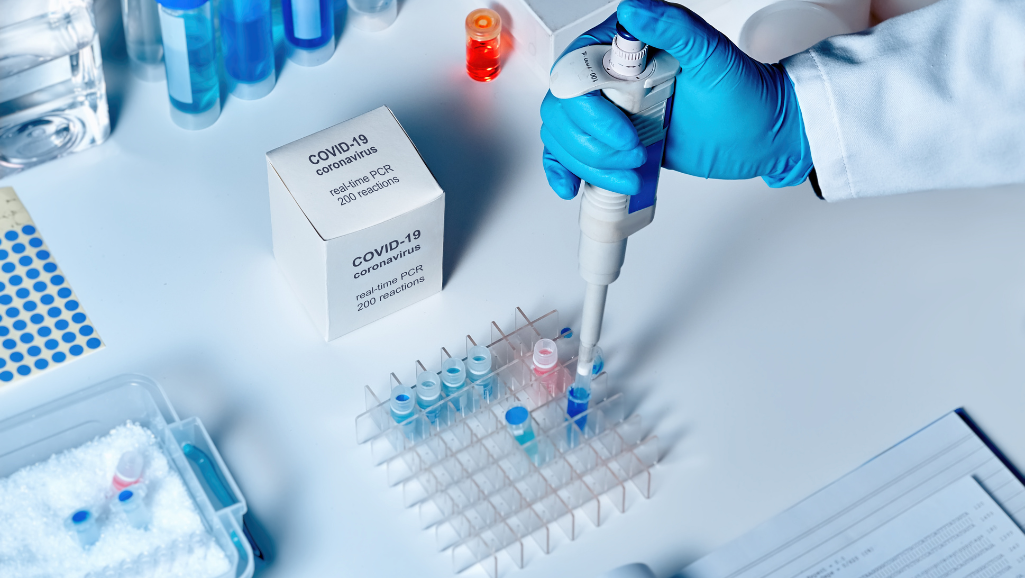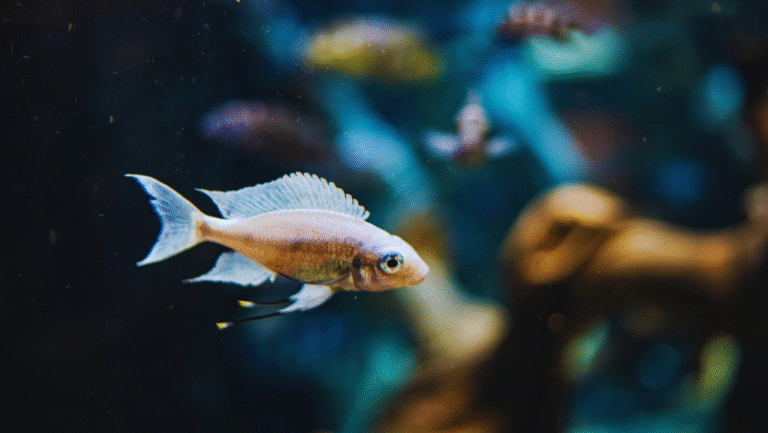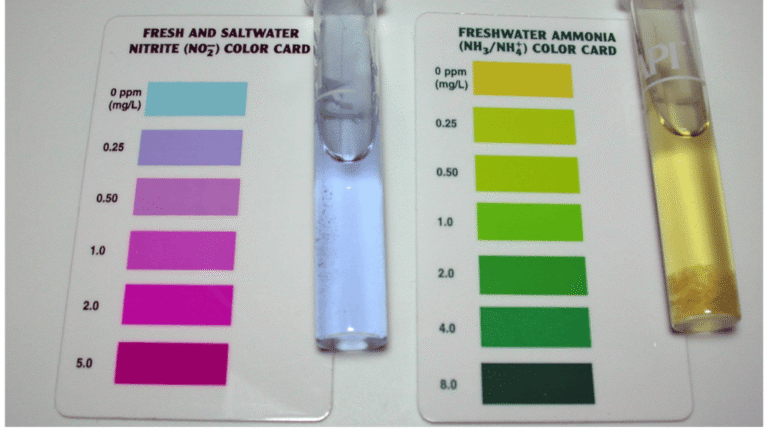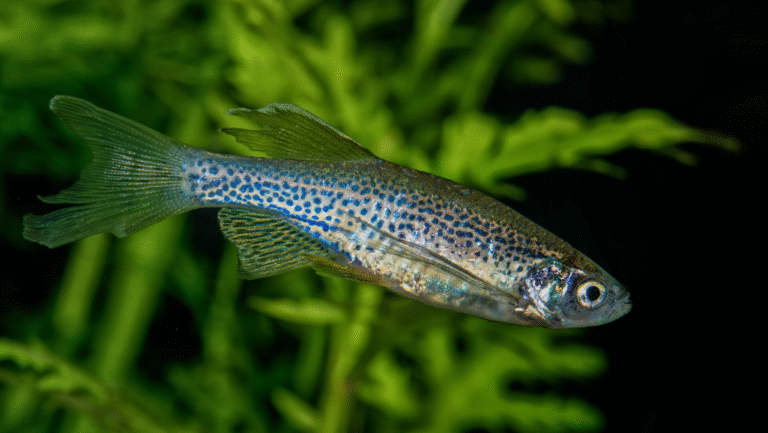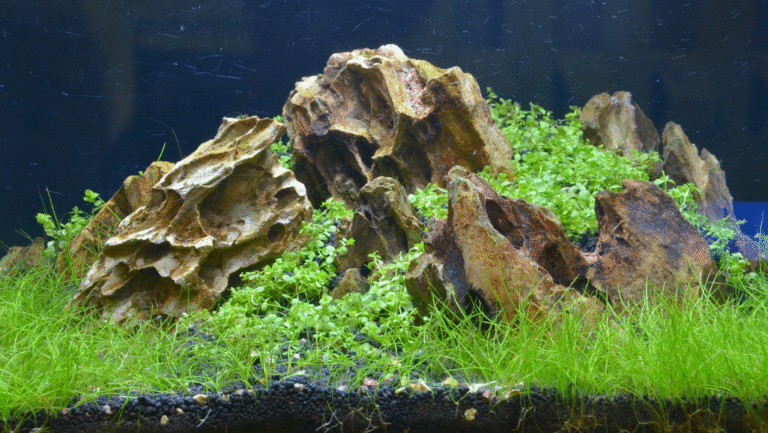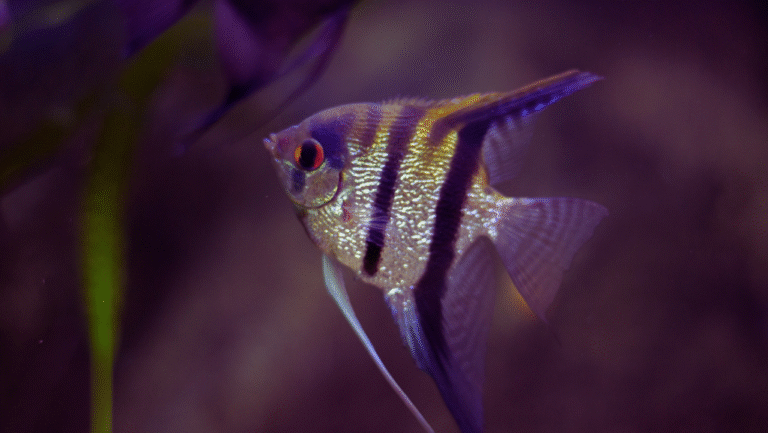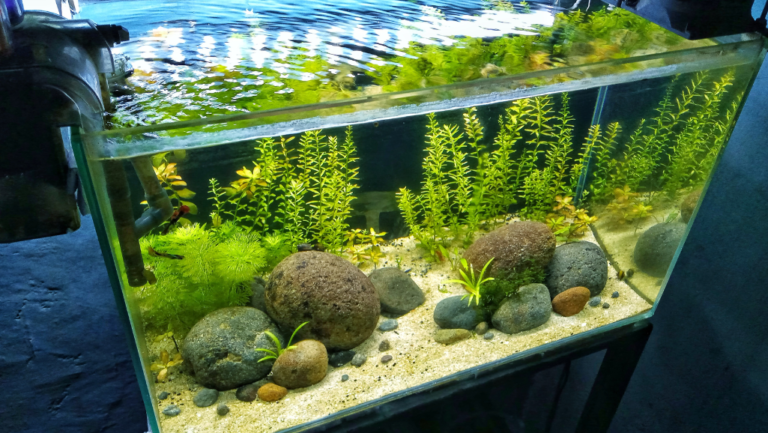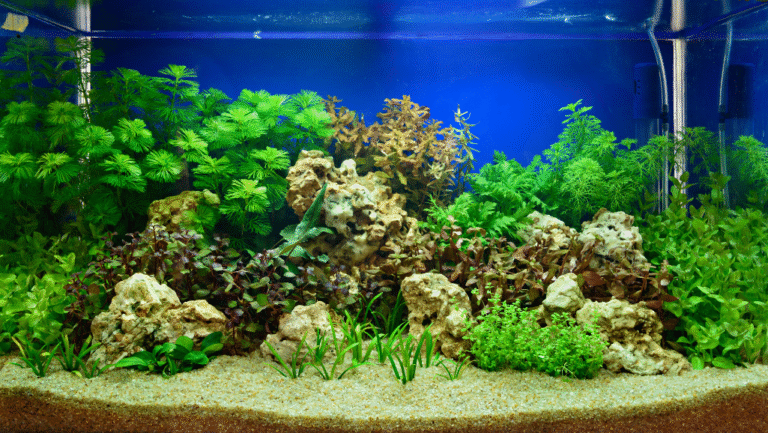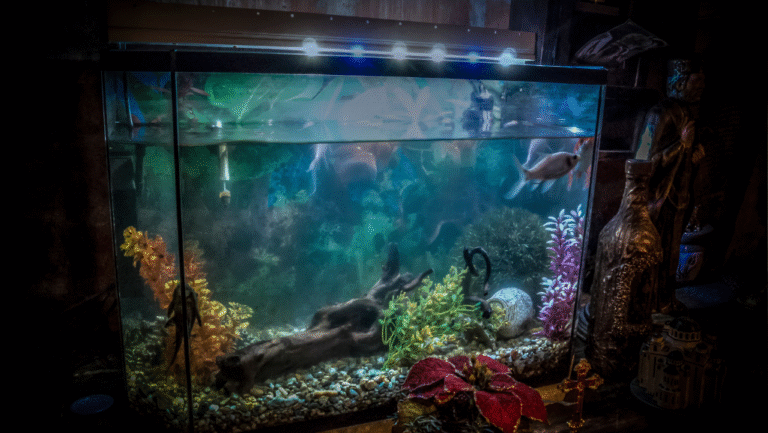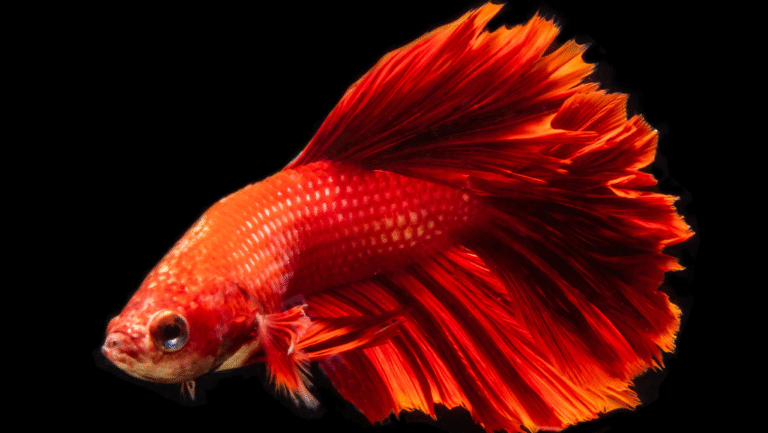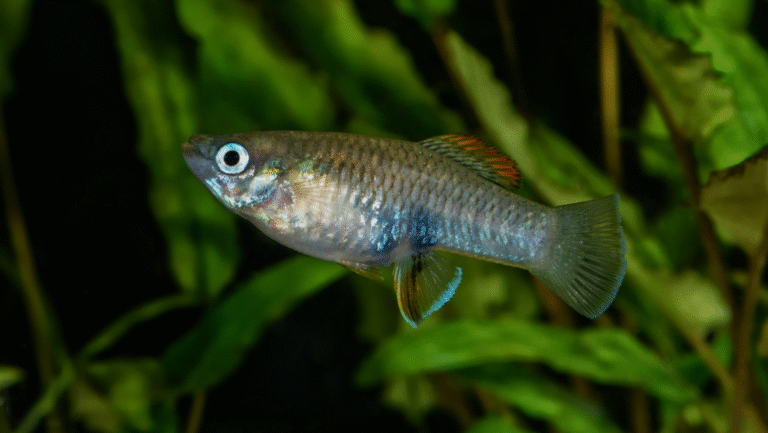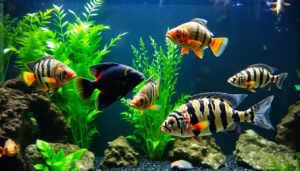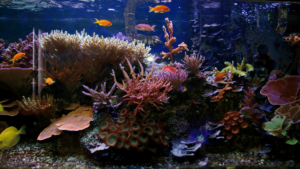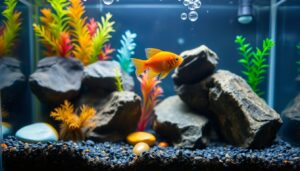Keeping your aquatic pets healthy starts with clean water. Many fish owners forget how crucial regular checks are. “Water quality is one of the most overlooked fish care tasks,” warns Dr. Jessica Fox, a renowned aquatic veterinarian. Without proper monitoring, harmful toxins can build up, leading to stressed or sick fish.
The API Freshwater Master Test Kit is trusted by experts for accurate results. It measures key factors like ammonia, nitrite, and pH levels. Ignoring these can cause serious harm, even death, to your underwater friends.
This guide covers everything from testing frequency to avoiding common mistakes. Learn why investing in reliable tools saves money—and lives—in the long run.
Key Takeaways
- Complete Aquarium Test Kit for Water Quality Monitoring.
- Regular water checks prevent fish stress and disease.
- Ammonia and nitrite spikes are silent killers in tanks.
- Professional-grade kits like API’s offer precise readings.
- Testing weekly catches problems before they escalate.
- Proper tool maintenance ensures long-term accuracy.
Why Water Quality Matters for Your Aquarium
Invisible toxins in your tank can silently harm fish before visible symptoms appear. “Clear water doesn’t mean safe water,” stresses Dr. Jessica Fox, recalling cases where fish suffered despite pristine-looking tanks. Harmful chemicals like ammonia or nitrites often lurk undetected.
The nitrogen cycle keeps your aquatic ecosystem stable. Waste breaks down into ammonia, which bacteria convert to nitrites, then nitrates. If this cycle stalls, toxins spike. Ammonia burns gills, while nitrites cause brown blood disease, suffocating fish by blocking oxygen transport.
pH swings are equally dangerous. Sudden changes stress fish, weakening their immune systems. Coral and sensitive species like discus need specific pH ranges to survive. Temperature also affects oxygen levels—warmer water holds less, risking hypoxia.
Regular water testing catches problems early. API studies show 80% of fish losses are preventable with weekly checks. Investing 5 minutes to test beats costly treatments or replacements later.
“Clients often blame disease when water quality is the real killer,” says Dr. Fox. “A $30 kit could save hundreds in vet bills.”
Stable parameters mean healthier fish, brighter colors, and active behavior. Don’t wait for warning signs—proactive monitoring is the key to a thriving tank.
Key Parameters to Test in Your Aquarium
Your fish’s survival hinges on invisible chemistry in their environment. Even slight imbalances in ammonia, pH, or salinity can trigger stress or fatalities. “Fish don’t show distress until it’s often too late,” notes marine biologist Dr. Liam Carter. Regular checks for these six metrics prevent crises before they start.
Ammonia, Nitrite, and Nitrate
The nitrogen cycle is your tank’s lifeline. Fish waste decays into ammonia—a toxin that burns gills at just 0.25 ppm. Beneficial bacteria convert it to nitrite, which blocks oxygen absorption. Finally, nitrite becomes nitrate, safer but harmful above 50 ppm in freshwater.
Freshwater tanks prioritize this trio, especially during cycling. Saltwater systems add complexity—coral reefs demand nitrates under 1 ppm. Test weekly, and act fast if ammonia or nitrite rise above zero.
pH and Carbonate Hardness (KH)
pH measures water’s acidity, but carbonate hardness (KH) stabilizes it. KH acts like a shock absorber, preventing sudden pH crashes. Aim for 3–8 dKH in freshwater; reefs need 8–12 dKH. Discus fish thrive at 6.5 pH, while African cichlids prefer 8.0+.
“A low KH tank is a ticking time bomb,” warns aquarist Rachel Nguyen. “One water change can crash pH, shocking fish.”
Salinity and Temperature
Saltwater tanks require precise salinity (1.023–1.025 specific gravity). Refractometers beat strips for accuracy. Temperature swings affect oxygen levels—72–82°F suits most freshwater fish, while reefs need 72–78°F. Use heaters with thermostats to avoid deadly fluctuations.
- Critical thresholds: Ammonia >0.25 ppm, nitrite >0 ppm, nitrate >50 ppm (freshwater) or >1 ppm (reefs).
- Test frequency: Daily during cycling, biweekly for mature tanks, immediately if fish act odd.
- Tool tips: Liquid kits for precision; match ranges to your species’ needs.
Types of Aquarium Test Kits
Choosing the right tools for water monitoring can make or break your aquatic environment. With various formats available, it’s essential to understand their strengths and limitations. Whether you’re a beginner or an experienced hobbyist, selecting the best option ensures accurate results and healthier fish.
Liquid Test Kits vs. Test Strips
Liquid kits are known for their precision. They involve adding reagents to water samples and comparing the resulting color to a chart. While they take more time, they’re ideal for detailed diagnostics. On the other hand, test strips offer quick results by simply dipping them into the water. However, they’re less accurate and can give false positives.
Strips are convenient for regular checks, but their shelf life is limited. Liquid kits, though pricier upfront, often provide better value per test. For reliable readings, many experts recommend combining both methods—using strips for quick scans and liquids for in-depth analysis.
Digital Monitors and Probes
Digital tools like the Yewhick Aquarium Monitor provide real-time tracking. They sync with apps to send alerts when parameters deviate. These devices are perfect for busy hobbyists who want continuous monitoring without manual effort.
Probes, such as the Hanna Checker pH Tester, offer unmatched accuracy with a resolution of 0.1 pH. However, they require regular calibration and have a lifespan of 10–12 months. While digital options are more expensive, their durability and precision make them a worthwhile investment for serious enthusiasts.
How to Choose the Right Aquarium Test Kit
Selecting the perfect tool for monitoring your tank’s health can feel overwhelming, but it’s crucial for your fish’s well-being. With so many options available, it’s essential to consider your specific needs, whether you’re managing a freshwater or saltwater setup.
Start by matching the tool to your tank’s bioload and size. Larger tanks or those with more fish require frequent monitoring, making a master kit like the API Freshwater Master Test Kit a smart choice. It offers 100 tests, ensuring long-term value.
For reef systems, the Red Sea Reef Foundation provides 75 tests per reagent, tailored to saltwater environments. Calculate the cost-per-test to determine which option fits your budget while delivering accuracy.
Consider the included accessories. Tubes, color charts, and storage cases add convenience and ensure proper use. Reagent expiration dates and storage needs are also critical—improper storage can compromise results.
- Freshwater vs. Saltwater: Match the tool to your tank type. Freshwater systems focus on ammonia, nitrite, and pH, while saltwater setups require precision for coral health.
- Brand Reputation: API and Red Sea are trusted brands, endorsed by communities like Reddit for their reliability.
- Supplemental Options: Use specialty tools like the NYOS Nitrate Test Kit for additional accuracy.
Finally, avoid the false economy of cheap strips. While they’re quick, they often lack precision. Investing in a reliable tool ensures accurate readings and healthier fish.
“A good test kit is like insurance for your tank—it catches problems before they become disasters,” says an experienced aquarist.
By evaluating your needs and comparing options, you’ll find the right tool to keep your aquatic environment thriving.
Best Overall: API Freshwater Master Test Kit
Maintaining a thriving underwater ecosystem starts with precise water monitoring. The API Freshwater Master Test Kit is a top choice for hobbyists and experts alike. It offers comprehensive testing for key parameters, ensuring your aquatic environment remains stable and healthy.
Pros and Cons
This master test kit includes seven reagents, four glass tubes, and a detailed color chart. It’s designed for 100 tests per parameter, making it a cost-effective option. However, some users report challenges with color interpretation, especially for nitrate readings.
- Pros: High accuracy, dual-range pH testing, and long-lasting reagents.
- Cons: Occasional false positives for nitrate, and color chart can be tricky to read.
Testing Parameters Covered
The API test kit measures pH, high-range pH, ammonia, nitrite, and nitrate. Its dual-range pH testing (0-14 and 6.5-8.5) ensures precise results for both freshwater and slightly alkaline environments. Ammonia and nitrite tests are highly reliable, catching harmful spikes early.
“The API kit is a lifesaver during tank cycling. It’s accurate and easy to use,” shared a Reddit user.
For best results, shake reagents thoroughly and read colors under natural light or a white background. The 2023 packaging improvements have made the kit more user-friendly, with clearer instructions and better storage options.
This tool is ideal for freshwater setups, from small tanks to large ecosystems. API’s customer support is also praised for its responsiveness, ensuring you get help when needed.
Best Saltwater Test Kit: Red Sea Reef Foundation
For reef enthusiasts, maintaining pristine water conditions is non-negotiable. The Red Sea Reef Foundation Pro Multi Test Kit is a top-tier solution designed to meet the unique demands of saltwater environments. It focuses on three critical parameters: calcium, magnesium, and alkalinity (KH), ensuring your reef thrives.
Coral health depends heavily on these elements. Calcium is essential for calcification, while magnesium prevents calcium depletion. KH stabilizes pH, preventing harmful fluctuations. The kit’s pictograph instructions make it user-friendly, even for beginners.
Compared to competitors like Hanna’s marine checkers, the Red Sea kit offers faster results without compromising accuracy. Each reagent provides 75 tests, making it cost-effective for long-term use. The rigid case ensures reagents stay protected, extending their shelf life.
For nano tanks, precise mixing ratios are included, ensuring accurate measurements even in smaller setups. However, note that basic parameters like ammonia and nitrite are excluded, requiring supplemental kits for comprehensive monitoring.
“The Red Sea Reef Foundation kit is a game-changer for serious reef keepers. Its accuracy and ease of use are unmatched,” says a professional aquarist.
In 2023, the formula was improved for even greater reliability. Pair it with Red Sea’s supplemental kits like Phosphate Pro or Magnesium Pro for a complete testing solution. Trusted by experts, this kit is a must-have for anyone committed to reef care.
Best for Ammonia Testing: Monitor Ammonia Test Kit
Ammonia levels can quickly turn a thriving aquatic environment into a hazardous zone. The Monitor Ammonia Test Kit is designed to detect even the smallest traces, ensuring your aquatic life remains safe. With a 150-test capacity, it’s a reliable choice for both beginners and experts.
This kit uses a top-down color wheel design, making it easier to read results compared to traditional side-read methods. Its detection range of 0-0.5ppm is ideal for catching early ammonia spikes, which are critical during the cycling phase.
False positives can be a concern with some kits, but the Monitor Ammonia Test Kit minimizes this risk. It includes vials and droppers for precise measurements, ensuring accurate results every time. Proper storage and adherence to instructions further enhance its reliability.
“This kit saved my shrimp tank during cycling. The color wheel design is a game-changer,” shared a satisfied user.
When comparing it to the API Ammonia Test Kit, the Monitor kit stands out for its ease of use and accuracy. The 2023 packaging updates have also improved its durability and user experience.
- Cycling Phase Testing: Essential for establishing a healthy nitrogen cycle.
- Color Wheel vs. Side-Read: Top-down designs reduce reading errors.
- Detection Range: 0-0.5ppm ensures early detection of harmful levels.
By integrating this kit into your tank cycling protocol, you can prevent ammonia-related issues before they escalate. Regular testing, combined with proper maintenance, ensures a safe and stable environment for your aquatic life.
Best Nitrate Test Kit: NYOS Nitrate Test
Accurate nitrate monitoring is essential for maintaining a balanced aquatic ecosystem. The NYOS Nitrate Test Kit stands out for its precision and ease of use. It’s compatible with freshwater, saltwater, and brackish systems, making it a versatile choice for hobbyists.
This tool features a 10-shade color chart with a range of 0 to 160 ppm. Reading results under natural light ensures accuracy. The two-step process—using one liquid and one dry reagent—simplifies testing while maintaining reliability.
Compared to competitors like Salifert’s discontinued kit, NYOS offers a broader color scale and quicker results. Its 11 distinct shades of yellow make it easier to interpret readings, even for beginners.
“The NYOS Nitrate Test Kit is a game-changer for nano reef keepers. Its clarity and accuracy are unmatched,” says a professional aquarist.
Common user errors include improper timing and insufficient shaking of reagents. To avoid mistakes, hold the test tube in natural light and read results on a white background. Proper storage also extends the shelf life of the reagents.
- Planted Tank Management: Ideal for monitoring nitrate levels in planted tanks, where excess nitrate can harm plants and fish.
- Marine vs. Freshwater Ranges: The broad 0-160 ppm range suits both marine and freshwater environments.
- Post-Water Change Testing: Test after water changes to ensure nitrate levels remain stable.
In 2023, the NYOS Nitrate Test Kit became more accessible through distribution channels like Amazon and Bulkreefsupply.com. Its improved packaging and user-friendly design make it a top choice for serious hobbyists.
Best Nitrite Test Kit: Monitor Nitrite Test Kit
Monitoring nitrite levels is a critical step in maintaining a balanced aquatic environment. As a midpoint in the nitrogen cycle, nitrite can quickly become toxic if unchecked. The Monitor Nitrite Test Kit offers precision and reliability, making it a top choice for hobbyists and experts alike.
This tool boasts a sensitivity of 0.1mg/L, ensuring even the smallest traces are detected. With a 200-test capacity, it’s a cost-effective solution for long-term use. The top-read color wheel simplifies result interpretation, reducing errors common with side-read methods.
Compared to the API Nitrite Test Kit, the Monitor kit provides a broader detection range and faster results. It’s ideal for diagnosing new tank syndrome, where nitrite spikes are common during cycling. Regular testing is also crucial when using medications, as some can disrupt biological filtration.
“The Monitor Nitrite Test Kit is a lifesaver for my axolotl tank. Its accuracy and ease of use are unmatched,” shared a satisfied user.
This kit is compatible with freshwater, saltwater, and brackish systems, making it versatile for various setups. For best results, clean test vials thoroughly after each use to avoid contamination. Pair it with a testing schedule during the cycling phase—daily for new tanks and biweekly for established ones.
While electronic probes offer continuous monitoring, they often come with higher costs and maintenance requirements. The Monitor Nitrite Test Kit provides a budget-friendly alternative without compromising accuracy. In 2023, it became more widely available through major retailers, ensuring accessibility for all hobbyists.
By integrating this tool into your routine, you can prevent nitrite-related issues before they escalate. Regular monitoring ensures a safe and stable environment for your aquatic life.
Best pH Test Kit: Sera pH Test Kit
pH levels play a critical role in the health of your aquatic environment. The Sera pH Test Kit is a reliable tool for monitoring this essential parameter. With a wide range of 4.5 to 9.0, it’s compatible with both marine and freshwater systems.
This kit includes 100 tests, making it ideal for regular monitoring. Diurnal pH fluctuations are common, especially in planted tanks or those with CO2 injection systems. The Sera kit helps track these changes, ensuring stability.
Compared to precision testers, the Sera kit offers a broader range, though it may not be as detailed for reef tanks. However, it’s perfect for African cichlid setups, where maintaining a higher pH is crucial. A case study involving driftwood acidification highlighted its accuracy in detecting subtle changes.
“The Sera pH Test Kit is a must-have for cichlid keepers. It’s easy to use and provides consistent results,” shared an experienced hobbyist.
Included accessories like vials and reagents ensure hassle-free testing. However, be cautious of light sensitivity—store reagents in a cool, dark place to maintain their effectiveness. Digital pens offer an alternative, but they require calibration and are less cost-effective.
In 2023, the Sera kit received updates to its formulation, improving accuracy and shelf life. Whether you’re managing a freshwater or marine setup, this tool is a valuable addition to your monitoring routine.
- Wide Range: 4.5–9.0 pH ensures compatibility with various systems.
- High Capacity: 100 tests provide long-term value.
- User-Friendly: Clear instructions and included accessories simplify use.
By integrating the Sera pH Test Kit into your routine, you can maintain a stable environment for your aquatic life. Regular monitoring prevents sudden changes, ensuring your fish and plants thrive.
Best KH/GH Test Kit: API GH & KH Test Kit
Understanding water chemistry is key to maintaining a healthy aquatic environment. The API GH & KH Test Kit is a trusted tool for measuring carbonate and general hardness, ensuring your water parameters stay balanced.
Carbonate hardness (KH) plays a crucial role in stabilizing pH levels. It acts as a buffer, preventing sudden pH swings that can stress aquatic life. Low KH can lead to acidic conditions, while high KH correlates with higher pH levels. Regular monitoring is essential, especially in planted tanks or those with CO2 injection systems.
General hardness (GH) measures the concentration of calcium and magnesium ions. These minerals are vital for fish health, particularly for species like livebearers and shrimp. Shrimp breeding, for example, requires specific GH levels to ensure proper molting and growth.
One common challenge with the API test kit is interpreting color changes. Some users report confusion, especially with expired reagents. “My test never changed color, and I later realized the reagents were out of date,” shared a hobbyist. Always check expiration dates and store reagents properly to avoid false readings.
The kit includes a conversion chart to translate dKH/dGH to ppm, but some users find it flawed. For precise adjustments during water changes, use the formula: Desired ppm = Current ppm + (Change in ppm). This ensures accurate adjustments without disrupting the tank’s balance.
“The API GH & KH Test Kit is a lifesaver for my livebearer tank. It’s easy to use and provides consistent results,” says an experienced aquarist.
Compared to the Red Sea KH Pro, the API kit offers broader compatibility for both freshwater and saltwater systems. While Red Sea excels in precision for reef tanks, API’s versatility makes it a better choice for mixed setups.
In 2023, API improved its customer support, addressing common issues like reagent expiration and color interpretation. These updates make the kit more reliable for hobbyists of all experience levels.
By integrating the API GH & KH Test Kit into your routine, you can maintain stable water conditions and ensure the health of your aquatic life. Regular monitoring prevents issues before they escalate, saving time and effort in the long run.
Best for Continuous Monitoring: Yewhick Aquarium Monitor
Real-time water monitoring is essential for maintaining a healthy aquatic environment. The Yewhick Aquarium Monitor offers a seamless solution, tracking pH, salinity, and temperature around the clock. With app integration and alerts, it ensures you’re always informed about your tank’s condition.
Unlike manual methods, this device provides continuous data, catching sudden spikes that might otherwise go unnoticed. “Automated systems like Yewhick are game-changers for busy hobbyists,” says a professional aquarist. Its IoT capabilities allow you to monitor your tank remotely, receiving instant notifications if parameters deviate.
Calibration is required monthly to maintain accuracy. While this adds a step, it ensures reliable results over time. The monitor is compatible with various tank sizes, from small indoor setups to larger ponds, making it versatile for different aquatic environments.
- 24/7 Tracking: Ensures no sudden changes go unnoticed.
- App Integration: Real-time alerts keep you informed remotely.
- Calibration: Monthly checks maintain long-term accuracy.
Compared to manual testing, which can miss critical fluctuations, the Yewhick system offers peace of mind. It’s also a strong competitor to Neptune Systems’ Apex, with a more user-friendly interface and affordable pricing.
“The Yewhick Aquarium Monitor has transformed how I manage my reef tank. Its reliability and ease of use are unmatched,” shared a satisfied user.
In 2023, firmware upgrades improved its performance, adding features like power outage backup solutions. This ensures uninterrupted monitoring, even during emergencies. However, users should be cautious of probe fouling in dirty tanks, which can affect accuracy.
By integrating the Yewhick Aquarium Monitor into your routine, you can maintain stable water conditions and ensure the health of your aquatic life. Its advanced features make it a must-have for serious hobbyists.
Essential Tips for Accurate Water Testing
Accurate water testing is the cornerstone of a thriving aquatic habitat. Whether you’re a beginner or an experienced hobbyist, mastering the art of monitoring ensures your underwater ecosystem remains healthy and stable. Here’s how to get it right every time.
How to Read Color Charts Correctly
Reading color charts can be tricky, but a few simple techniques can improve accuracy. Always use natural sunlight or a white background when comparing colors. Artificial lighting can distort results, leading to misreadings.
For liquid tests, ensure the vial is clean and free of residue. API’s protocol recommends rinsing vials with distilled water before each use. This prevents contamination and ensures consistent results.
When reading the meniscus (the curve at the liquid’s surface), align your eyes with the mark for precision. Color-blind hobbyists can benefit from digital testers, which provide numerical readings instead of relying on color interpretation.
When to Test Your Aquarium Water
Timing is critical for accurate results. Avoid testing immediately after feeding, as uneaten food can skew readings. Instead, wait at least an hour to ensure the water has stabilized.
Test during consistent times, such as morning or evening, to monitor pH fluctuations. Dawn and dusk are ideal for detecting diurnal changes, especially in planted tanks or those with CO2 injection systems.
After water changes, wait 24 hours before testing to allow parameters to stabilize. This ensures you’re measuring the true state of your aquatic environment.
“Proper timing and technique are as important as the tools themselves. A little patience goes a long way in ensuring accurate results,” says an experienced aquarist.
By following these tips, you can avoid common pitfalls and maintain a healthy aquatic habitat. Regular monitoring, combined with proper techniques, ensures your underwater friends thrive.
Common Mistakes to Avoid with Aquarium Test Kits
Ensuring accurate water monitoring requires avoiding common pitfalls that can lead to misleading results. Even the best tools can fail if not used correctly. Here’s how to sidestep errors and get reliable readings every time.
One frequent issue is false positives caused by unshaken reagents. Always shake bottles thoroughly before use. Skipping this step can lead to inaccurate color changes, especially with liquid-based test kits.
Expired reagents are another culprit. Over time, chemicals degrade, producing unreliable results. Check expiration dates and store reagents in a cool, dark place. “Using outdated solutions is like guessing—you’ll never know if the reading is correct,” warns an experienced hobbyist.
Cross-contaminated vials can also skew results. Always rinse vials with distilled water between tests. Using dropper bottles at an angle or improper handling can introduce errors. For precise measurements, hold droppers vertically and follow instructions carefully.
Eyeballing measurements is a risky shortcut. Even slight deviations in reagent amounts can lead to significant inaccuracies. Use the exact number of drops specified, and avoid estimating.
Sequential testing order matters. Start with pH, then move to ammonia, nitrite, and nitrate. This prevents cross-reactions between chemicals. Skipping steps or mixing tests can compromise results.
Budget options may save money, but they often sacrifice accuracy. Invest in trusted brands like API or Hanna Instruments for reliable readings. Generic reagents may not meet the same standards, leading to inconsistent results.
Unit conversion errors, such as confusing ppm with dKH, are common. Always double-check charts and formulas to ensure correct interpretations. Misreading units can lead to incorrect adjustments.
Incompatible test media combinations can also cause issues. Avoid mixing reagents from different brands unless specified. Cross-brand reactions can produce false readings or damage equipment.
Local fish store (LFS) comparisons can be misleading. While convenient, their tests may not match the precision of home kits. Use LFS results as a supplement, not a replacement, for your own testing.
Proper storage is critical. Keep reagents away from heat, light, and moisture. Improper storage can shorten shelf life and reduce accuracy. Store kits in their original cases to protect components.
Beware of counterfeit products, especially on platforms like Amazon. Stick to authorized sellers to ensure authenticity. In 2023, counterfeit identification improved, but vigilance is still essential.
By avoiding these mistakes, you can ensure accurate water monitoring and maintain a healthy aquatic environment. Proper technique and reliable tools are the keys to success.
How Often Should You Test Your Aquarium Water?
Understanding the right frequency for water checks can make all the difference. Regular monitoring ensures your aquatic environment remains stable and healthy. API recommends a weekly minimum for established setups, but specific situations may require more frequent checks.
For new setups, daily testing is crucial during the cycling phase. This helps track ammonia and nitrite spikes, ensuring the nitrogen cycle establishes properly. Once stabilized, reduce testing to every 3 days, then weekly, and finally monthly for mature systems.
Event-based triggers also dictate when to test. If fish show signs of illness, after medication use, or when introducing new inhabitants, check all parameters immediately. Seasonal temperature fluctuations can affect water chemistry, so adjust testing frequency accordingly.
Planted setups have unique needs. Monitor nitrate levels (25-50 ppm) and phosphate regularly, especially with CO2 injection. Outdoor ponds require testing 3-4 times a year, focusing on seasonal changes.
“Over-testing can stress fish, but under-testing risks their health. Find the right balance for your setup,” advises an experienced aquarist.
Post-medication protocols are critical. Medications can disrupt biological filtration, so test ammonia and nitrite levels afterward. Vacation prep also requires a thorough check to ensure stability while you’re away.
Smart testers offer automation benefits, providing real-time data and alerts. While convenient, they don’t replace manual checks entirely. Use them as a supplement to ensure comprehensive monitoring.
By tailoring your testing schedule to your setup’s needs, you can maintain a thriving aquatic environment. Regular checks catch issues early, saving time and effort in the long run.
Conclusion
Ensuring the health of your underwater ecosystem begins with consistent and accurate monitoring. Regular checks for ammonia, nitrite, nitrate, and pH are essential to prevent harmful spikes. The API Master Test Kit offers a reliable solution with its 100-test capacity, making it a cost-effective choice for long-term use.
For comprehensive monitoring, consider a hybrid approach. Pair the API test kit with specialty tools for specific parameters like nitrate or KH. This ensures precise readings and a balanced environment for your aquatic life.
Even in mature tanks, complacency can lead to unnoticed issues. Upgrade to digital systems like the Yewhick Aquarium Monitor for real-time tracking and alerts. These tools provide peace of mind and catch problems before they escalate.
Dr. Jessica Fox emphasizes that 80% of fish losses are preventable with regular testing. Investing in reliable equipment saves both money and lives. Start your weekly testing schedule today to keep your aquatic environment thriving.
